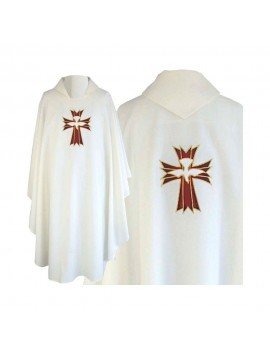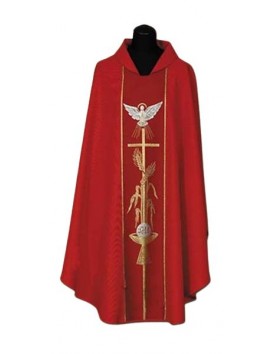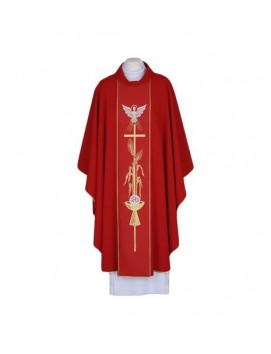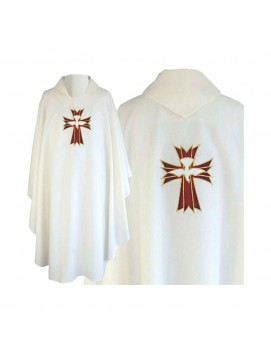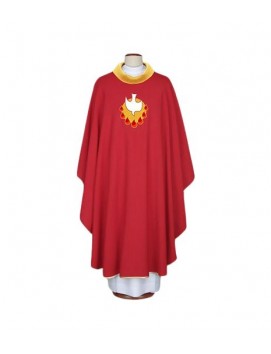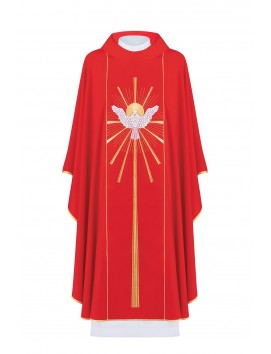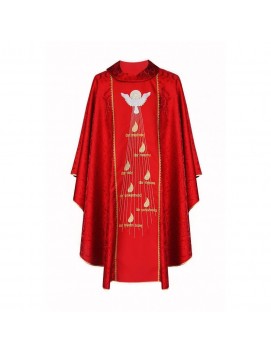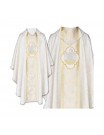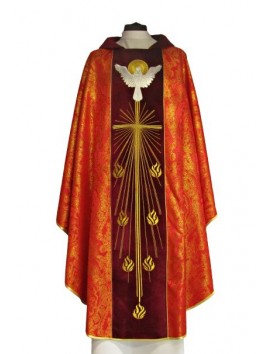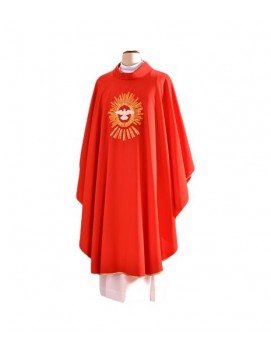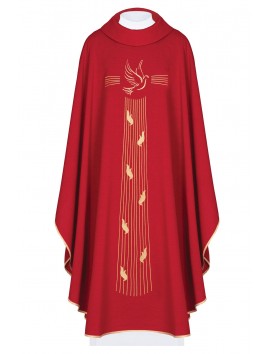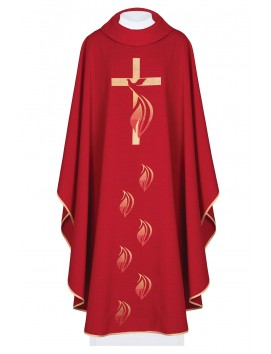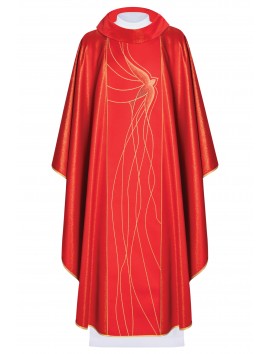No products
Chasubles with Holy Spirit
Chasubles with Holy Spirit are liturgical vestments that feature symbols of the Holy Spirit. These symbols can include images of a dove, flames, or other representations of the Holy Spirit's presence. Chasubles with the Holy Spirit are often seen in Gothic churches as part of their traditional vestments. They are available in various styles, including Gothic and Semi-Gothic. Chasubles with the Holy Spirit are often made of high-quality fabrics such as wool and silk, and are decorated with intricate embroidery and gold brocade trim.
Chasubles with Holy Spirit are liturgical vestments that feature symbols of the Holy Spirit. These symbols can include images of a dove, flames, or other representations of the Holy Spirit's presence. Chasubles with the Holy Spirit are often seen in Gothic churches as part of their traditional vestments. They are available in various styles, including Gothic and Semi-Gothic. Chasubles with the Holy Spirit are often made of high-quality fabrics such as wool and silk, and are decorated with intricate embroidery and gold brocade trim.
Chasubles with Holy Spirit: A Divine Garment of Faith
Chasubles, sacred garments with Holy Spirit imagery, are not just pieces of fabric; they are profound symbols of faith, worn by priests during the celebration of the Mass and other religious ceremonies. These sacred vestments carry deep spiritual significance, embodying the presence and guidance of the Holy Spirit in the liturgical service for clergy members during religious ceremonies. Let's dive into the world of these divine garments and uncover their importance in the Catholic faith, spiritual significance for clergy members in religious ceremonies and liturgical celebrations.
The Symbolism of Chasubles with Holy Spirit
Chasubles, sacred garments with Holy Spirit designs, carry spiritual significance and divine presence, inspired by divine inspiration. They serve as a constant reminder of the Holy Spirit's active presence in the life of the Church and its sacraments, religious ceremonies, and clergy members. The Holy Spirit, often depicted as a dove, symbolizes peace, purity, and God's grace descending upon the faithful divine presence. When a priest dons chasubles adorned with the Holy Spirit's presence, it signifies the significance of the invocation of the Spirit's guidance and blessings during the sacred liturgy.
The Evolution of Chasubles in Liturgical Wear
The chasuble has undergone significant transformations throughout Christian history. Originally, it was a simple, poncho-like garment that covered the wearer completely. Over time, its design evolved to become more formal and symbolic, incorporating various colors and symbols according to the liturgical season or specific celebration. Chasubles with Holy Spirit imagery are particularly used during occasions that emphasize the role of the Spirit, such as Pentecost, highlighting its presence and significance.
The Importance of Color in Chasubles
The color of chasubles is not chosen at random, as it holds significance and represents the presence of the Holy Spirit. Each color holds specific meanings and significance, and is used during particular times of the liturgical year. For instance, red chasubles, often adorned with the Holy Spirit, are worn during Pentecost to symbolize the tongues of fire that descended upon the apostles. This vivid imagery brings to life the transformative power of the Holy Spirit in the Church.
Chasubles with Holy Spirit in Modern Times
Despite the evolution of fashion and trends, chasubles with Holy Spirit imagery remain a timeless element in Catholic worship. They bridge the gap between ancient tradition and contemporary faith, reminding both the clergy and the congregation of the enduring presence of the Holy Spirit. Modern chasubles blend traditional symbolism with contemporary design, making them relevant and meaningful in today's liturgical celebrations.
Frequently Asked Questions about Chasubles with Holy Spirit
Q: Can chasubles with Holy Spirit be worn throughout the year?
A: While chasubles with Holy Spirit are particularly significant during Pentecost, they can be worn at other times as well, especially during celebrations or sacraments that emphasize the role of the Holy Spirit.
Q: Are there specific materials used for making chasubles with Holy Spirit?
A: Chasubles can be made from various materials, but the choice often depends on the preference of the parish or the celebrant. Lightweight and breathable fabrics are commonly used to ensure comfort during the service.
Q: How are chasubles with Holy Spirit designs created?
A: These designs can be embroidered, printed, or woven into the fabric, each method adding a unique beauty and depth to the garment. The choice of design technique often reflects the artistic tradition of the community or the personal taste of the priest.
Conclusion: A Garment of Divine Presence
Chasubles with Holy Spirit are not just articles of clothing; they are garments of divine presence, worn to invite and celebrate the guidance of the Holy Spirit in the liturgy. Through their rich symbolism and historical significance, these chasubles continue to inspire faith and devotion in the hearts of the faithful, bridging heaven and earth in the celebration of the Mass.

